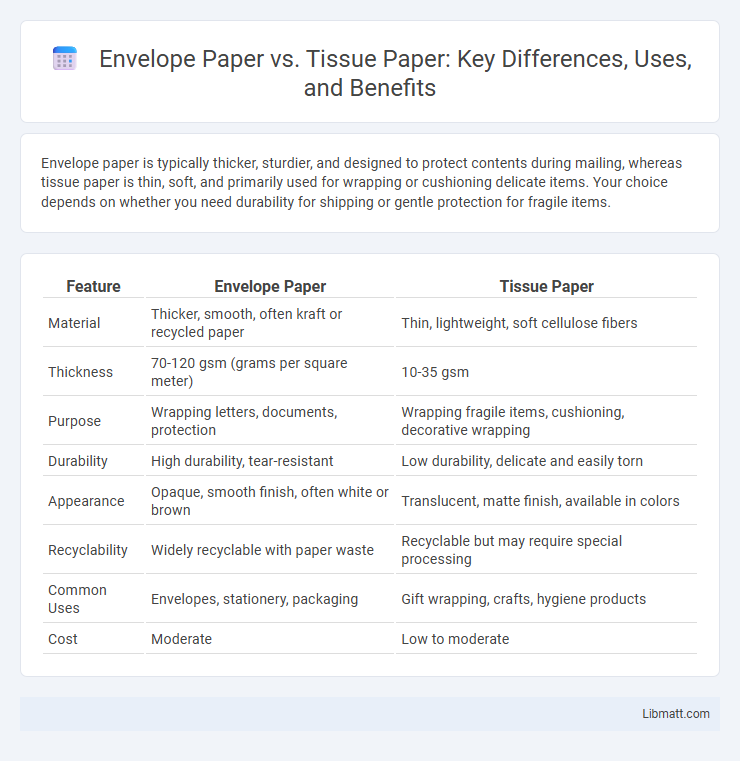Envelope paper is typically thicker, sturdier, and designed to protect contents during mailing, whereas tissue paper is thin, soft, and primarily used for wrapping or cushioning delicate items. Your choice depends on whether you need durability for shipping or gentle protection for fragile items.
Table of Comparison
| Feature | Envelope Paper | Tissue Paper |
|---|---|---|
| Material | Thicker, smooth, often kraft or recycled paper | Thin, lightweight, soft cellulose fibers |
| Thickness | 70-120 gsm (grams per square meter) | 10-35 gsm |
| Purpose | Wrapping letters, documents, protection | Wrapping fragile items, cushioning, decorative wrapping |
| Durability | High durability, tear-resistant | Low durability, delicate and easily torn |
| Appearance | Opaque, smooth finish, often white or brown | Translucent, matte finish, available in colors |
| Recyclability | Widely recyclable with paper waste | Recyclable but may require special processing |
| Common Uses | Envelopes, stationery, packaging | Gift wrapping, crafts, hygiene products |
| Cost | Moderate | Low to moderate |
Introduction to Envelope Paper and Tissue Paper
Envelope paper is typically thicker and more rigid, designed to protect documents during mailing with properties like durability and opacity. Tissue paper is thin, lightweight, and semi-translucent, commonly used for wrapping delicate items or cushioning in packaging. Both materials serve distinct purposes based on their structural characteristics and intended use.
Key Differences between Envelope Paper and Tissue Paper
Envelope paper is typically thicker and more durable, designed to protect contents during mailing, while tissue paper is thin, lightweight, and primarily used for wrapping or cushioning delicate items. You'll find envelope paper often has a smooth, sturdy texture and may include security features like watermarks, whereas tissue paper is soft, translucent, and easily foldable. The distinct thickness, strength, and intended use clearly differentiate envelope paper from tissue paper in packaging and presentation.
Common Uses of Envelope Paper
Envelope paper is specifically designed for durability and smooth printing, making it ideal for mailing invitations, business correspondence, and official documents. Its heavier weight and slightly textured surface provide a professional appearance and enhanced protection during postal handling. Unlike tissue paper, which is lightweight and fragile, envelope paper withstands folding and handling without tearing, ensuring contents remain intact.
Popular Applications of Tissue Paper
Tissue paper is widely used in gift wrapping and packaging for its lightweight, translucent properties that provide protection and aesthetic appeal. It is also a staple in arts and crafts, including decoupage and paper mache, due to its flexibility and ease of manipulation. In addition, tissue paper serves hygienic purposes in facial tissues, wipes, and sanitary products, highlighting its versatility across consumer goods.
Material Composition and Texture Comparison
Envelope paper typically consists of tightly woven fibers made from wood pulp or recycled paper, resulting in a sturdy, smooth texture ideal for durability and protection during mailing. Tissue paper is crafted from refined wood pulp and contains a high percentage of water and air, producing a delicate, lightweight texture optimized for softness and flexibility. The dense fiber matrix in envelope paper contrasts with the loosely bonded fibers in tissue paper, affecting their respective thickness and tactile feel.
Durability: Envelope Paper vs Tissue Paper
Envelope paper offers significantly higher durability compared to tissue paper due to its thicker, sturdier composition, making it ideal for securely protecting documents during mailing or storage. Tissue paper, being thinner and more delicate, is prone to tearing and damage, which limits its use to lightweight wrapping or cushioning rather than protective purposes. Choosing envelope paper ensures your important contents remain intact and safe from environmental wear and handling stress.
Environmental Impact and Sustainability
Envelope paper is typically more durable and less biodegradable than tissue paper, contributing to longer decomposition times in landfills and greater environmental impact. Tissue paper, often made from recycled fibers and designed for single use, decomposes faster and generally has a lower carbon footprint when sourced sustainably. Choosing your packaging materials based on the sustainability certifications and recyclability can significantly reduce environmental harm.
Cost Analysis: Which is More Affordable?
Envelope paper generally costs more per sheet than tissue paper due to its thicker material and durability designed for mailing purposes. Tissue paper is more affordable and sold in bulk, making it economical for packaging and wrapping. Businesses seeking budget-friendly options often prefer tissue paper, while envelope paper is chosen for secure, professional correspondence despite higher costs.
Creative Uses in Arts and Crafts
Envelope paper offers a sturdy texture ideal for making cards, scrapbooks, and origami projects, providing a firm base for intricate designs and embellishments. Tissue paper is prized for its lightweight, translucent qualities, perfect for layering in collages, creating delicate flowers, and adding dimensional effects in mixed media art. Combining envelope paper with tissue paper enhances creativity by balancing structure with softness, enabling unique textural contrasts in arts and crafts.
Choosing the Right Paper for Your Project
Envelope paper offers durability and a smooth finish ideal for formal invitations and important correspondence, while tissue paper provides a delicate texture perfect for gift wrapping and creative crafts. Your choice depends on whether your project requires sturdiness or a lightweight, decorative touch. Selecting the right paper ensures your project's presentation aligns perfectly with its purpose and aesthetic.
Envelope paper vs tissue paper Infographic

 libmatt.com
libmatt.com